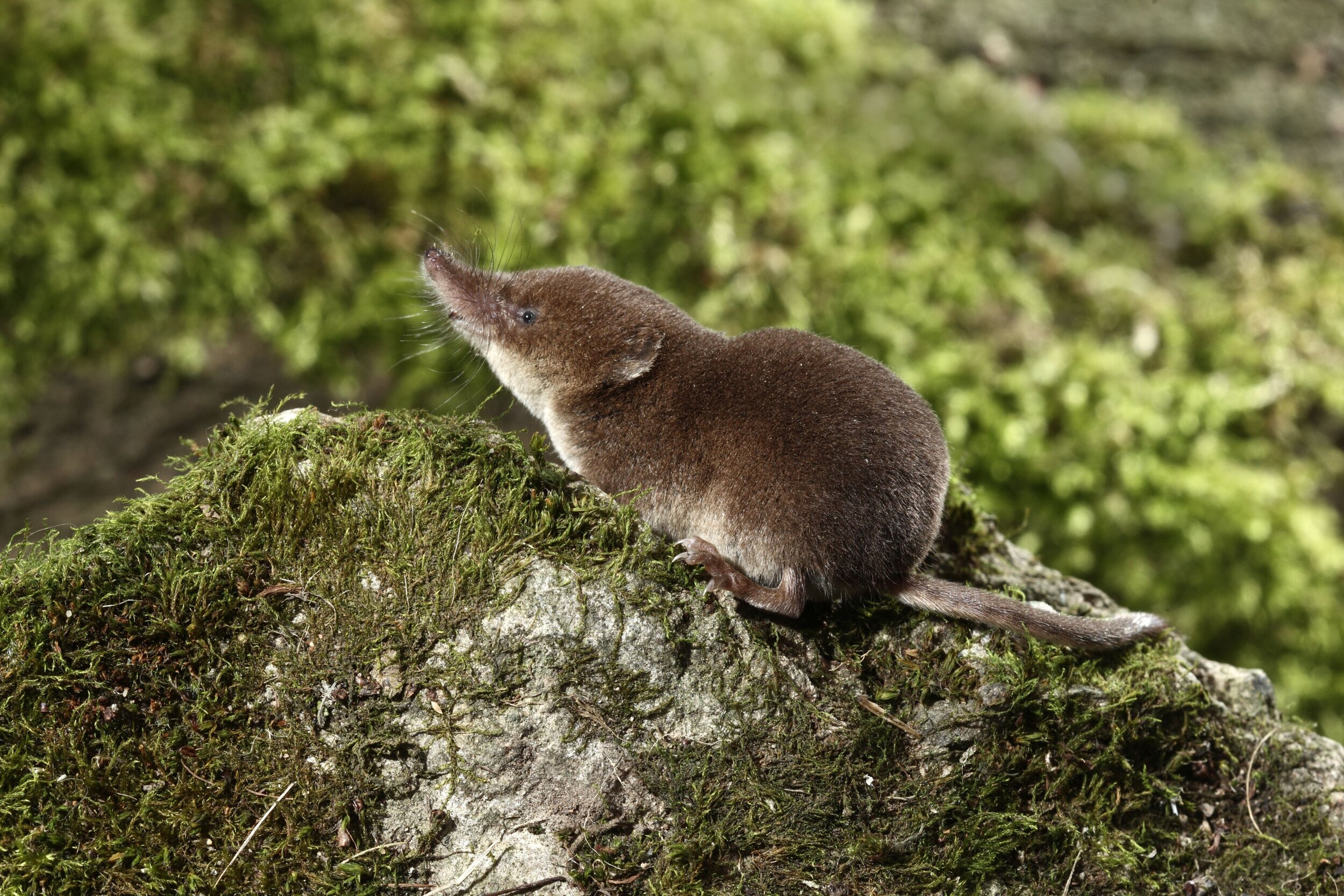A common shrew (photo: PTES)
Fact file
Latin name
Sorex araneus
Threat status
Least Concern (Global)
Least Concern (Europe)
Least Concern (UK)
Etymology
Sorex and araneus mean ‘shrew’ and ‘spider’ respectively. Well, the first part makes sense but why ‘spider’? This part comes from an old folk belief that shrews were venomous or bad luck; if a shrew even crossed your path you could come ‘shrew-struck’ and fall ill.
Though common shrews aren’t actually venomous, one species of UK shrew, the water shrew, is which may be where this belief started. However, the bite is just uncomfortable, it doesn’t make you ill!
Identifying features
Compared to mice and voles, shrews tend to be smaller, with longer, more pointed snouts and very small eyes.
The common shrew is brown on its upper surface, with a white/cream under side. This distinguishes it from the water shrew, which is black on top.
It looks quite similar to the pygmy shrew, though is larger in size. Common shrews also have a sharp contrast between the brown top fur and white underside, whilst the pygmy shrew has a more gradual change in colour.
Habitat
They can be found in almost all habitats where low vegetation cover is available. They prefer thick grass, broad-leaved woodland, hedgerows and scrubby land.
Numbers
Common shrews occur in variable densities depending on the habitat, up to 98 per hectare. However, all populations go through regular cycles, with peak numbers in summer that decline through autumn and winter as the older individuals die and the young disperse. Current estimates suggest there are 21.1 million (95% CI: 6.5 million – 58.5 million) common shrews in the UK, from the Mammal Society Review of the Population and Conservation Status of British Mammals.
Distribution
Common shrews can be found across eastern Europe (from the eastern border of France) and most of Russia. It is wide spread across the mainland UK, though absent from the Scottish highlands and Ireland. It is present on several islands such as the Isle of White and Skye, but noticeably absent from more distant islands, such as Orkney and Shetland.
Diet
Like all shrews, common shrews are insectivores, consuming a wide variety of insects, spiders, slugs and earthworms. They will eat anything they can, but prefer not eat some invertebrates like millipedes. They occasionally to eat some plant material as well. Common shrews also eat more subterranean prey such as earthworms, than pygmy or water shrews.
Size
They are relatively small, only 4.8 to 8cm long in head and body and 2.4 to 4.4cm in tail. They weigh around 4 to 14g.
Life span
Only 15 to 18 months.
Breeding
Common shrews can have 1 to 11 pups in a litter, but generally have 4 to 8. Breeding season lasts from April to September, with young maturing over winter to breed in the following year. Females commonly only have 2 litters in a season, but have been known to have 4-5. The young are fully independent in only 22-25 days.
A long worth live trap with a shrew hole (photo: NHBS)
Survey techniques
Common shrews can easily be caught in live traps, but they must have hay and invertebrate/meat bait (e.g. meal worm, fly pupae, wet cat food) if they are to survive in the traps. Live traps can also come with shrew-holes, which allow smaller shrews to escape whilst keeping mice/voles in the traps.
There are no distinctive signs of common shrews, though they do make runs in vegetation and excavate burrows. They do make a call that we can just hear, a very high-pitched rapid ‘chee-chee-chee’ sounds when they are alarmed.
Legislation in the UK
All shrews are protected by a general licence in the UK, which is required for live trapping. This can be found online, and requires that all dead shrews are reported.
Shrinking Shrews
Common shrews markedly decrease their body weight by shrinking their skeleton (especially the skull) and some internal organs! This helps them to survive winter as smaller shrews need less energy to survuve, and so can cope with less food. In Britain, common shrews shrink by about 12-20%, but in northern Europe body weight can decrease by up to 45%. Then in spring, their body mass rapidly increases so they are ready for the breeding season - they actually become larger than previous autumn. This phenomenon is known as the ‘Dehnel effect’, after the zoologist that first discovered it.
Common shrew skull sizes in different months (Adapted from Figure 1 of Dechmann et al, 2017, Scientific Reports)
Little Fighters
Common shrews (and most shrew species to be honest) are incredibly aggressive. When a shrews meets a stranger they loudly squeak, which we can just hear, and rear on their hind legs to try and scare them off. Then the stranger will be chased off, and a scuffle may occur where they aim to bite each others heads and tails. Often you can see scars on common shrew tails from previous battles! They are also aggressive in mating, with males biting the female’s scruff so hard that they often leave a bald patch. Anyone live trapping knows to beware a nasty nip from these shrews!
However, shrews have one redeeming feature - they wag their tails from side to side when excited!



